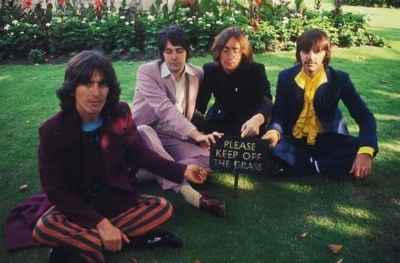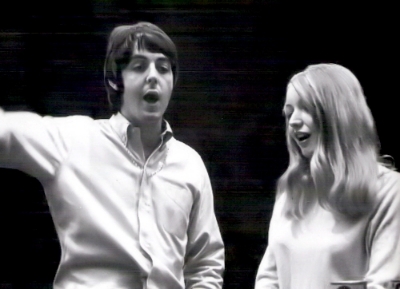Q: Where are the other two Beatles?
John Lennon: No idea.
Paul McCartney: In bed, probably. Oh, in England.
Q: What are your plans for opening a club in New York?
John Lennon: I don't know. There aren't any real plans.
Q: What about the rumors that you're going to buy Generation?
John Lennon: What about them? I didn't hear of it till Sunday myself!
Q: Will the four Beatles own 100% of Apple? And will you be equal partners?
John Lennon: Yes.
Q: Do you think that some of your records are influencing the minds of the younger generation?
John Lennon: Well, everybody's records influence the mind, you know. All at once. Everything influences everything. Nilsson's my favorite group.
Q: Would you comment on the mood of youth around the world, the protest movement, and what's going on?
Paul McCartney: People want to know what's going on, and no one knows at the moment.
John Lennon: Whether the movement is right or wrong, it's better than no movement.
Q: Do you have any specific reason for going on The Tonight Show tonight?
John Lennon: I don't know what happened.
Paul McCartney: We just seemed to be on it.
Q: I just wanted to ask you how you are!
Paul McCartney: Quite well! Hey, and how are you!?!
Q: High!
Paul McCartney: Six feet high and rising?
Q: Would you say that Magical Mystery Tour is a better or worse album than Sgt Pepper?
John Lennon: It's not an album, you see. It's turned into an album over here, but it was just music from the film. Then, it's not an album.
Q: Has the film been bought over here?
John Lennon: I haven't a clue and I really don't care.
Q: Do George and Ringo feel the same way as you do about the Maharishi?
John Lennon: Yes. We tend to go in and out together, I mean, with a few spaces. So, yes.
Q: Are the Beatles going to make another movie this summer?
John Lennon: Well, we don't know when we're going to make it, but it will be this year or the early part of next year.
Q: What did you think of the critical reception to Magical Mystery Tour?
John Lennon: Well, I mean, it's... it doesn't matter. But it does. Oh, it really doesn't matter, you know. Why it's not on now is what matters.
Paul McCartney: They were disappointed.
Q: Were the criticisms valid?
John Lennon: Valid? I didn't see any valid points. It was just hysteria and that bit.
Paul McCartney: You see, they expected a tinselly Christmas show, because it was shown on Christmas - and you know that it was very different from that, so we shocked them a bit.
John Lennon: They didn't like it, you know. They thought we were stepping out of our roles. They like us to stay in the cardboard suits they designed for us.
Q: What roles do they want you to stay in?
John Lennon: Well, whatever image they have for themselves, they're disappointed if we don't fulfil it. We never do, so there's always a lot of disappointment.
Q: Do you think press conferences are a drag?
John Lennon: Well, they're not something I choose to do, but they're fun. It's work and business.
Q: Paul, what do you think of Jimi Hendrix?
Paul McCartney: He's great.
Q: Why do the Beatles meditate?
Paul McCartney: Because it seems to be nice. Like cleaning your teeth, you know, it just has some kind of end product.
Q: What do you think of the Mothers of Invention?
Paul McCartney: I think they're doing very well.
Q: What did the Beatles have to do with the creation of the marvellous fantasy characters in the Yellow Submarine?
Paul McCartney: Not much. There's a really good artist named Heinz (Edelmann) who created them.
Q: Do you plan to sing in French or in any other language other than English?
John Lennon: No, we don't make plans. We did She Loves You in German, and that was about it, I think.
Paul McCartney: Then, the English version became a hit, you know.
Q: How often do you turn on?
John Lennon: It's happening all the time, you know.
Q: Will you be doing a TV special soon?
John Lennon: I don't know.
Paul McCartney: Maybe. Quite possibly.
John Lennon: We've got to do another album. We don't know what happens until we do that.
Q: Have you ever thought of making a record, a film, or a TV special over here?
John Lennon: It's quite possible, yes. Why not? Except that we live over there.
Q: But you could fly over again.
John Lennon: Yeah, sure. But is it worth the journey?
Q: Are there any plans for an Apple clothing store in the United States?
John Lennon: No. No plans.
Q: What is the meaning of I Am The Walrus?
John Lennon: It just means, I am the walrus. Or I was when I sat down, you know.


















